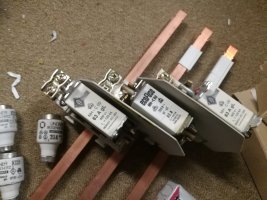I never realised how confusing a relatively simple device can be made to appear.
AC breakers - they use an inline coil with a bit of metal to effectively create a small electromagnet. The breaker is setup like a mousetrap so that the relatively little force of the magnet cen then trip open a contact. The coil and bit of metal work in both directions and the arc is extinguished by the zero volt crossing of AC.
DC Breakers are the same setup BUT they have a magnet near the contact opening to push or pull the arc to make it longer and therefore extinguish itlef. The polarity of the magnet in relation to the current direction is what it is all about because of where the arc is moved.
Fuses - there are two basic types, filled or not. High voltage fuses are fulled with sand or something similar to melt and or create an insulating vapour poccket to extinguish the arc. Low voltage fuses just rely on the wire melting. FUSES ARE NOT DIRECTIONAL.
DC circuit breakers that are not voltage rated for DC or using an AC breaker that is too low a voltage. The contacts do not create a gap large enough and I have personally stood and watched one of my 10A AC breakers arc and start smoking until I switched it off via a second breaker. That was with just 140V.
High current DC breakers have a totally different issue because the fault current curve when you start looking at 125A breakers and alike, your wiring may end up becoming the fuse wire because with C type curve you could end up with 500A for longer than your wire insulation can avoid smoking before the breaker trips.
Fault current handling is a different issue again because vapourising the internals creates a conductive ionised cloud.
AND just because abreaker costs 10x more than a cheap China knock off it does no mean the cheap option is not as safe or reliable. I use TOMZN breakers for below 40A and trust them after burning a few out with experiments and trips. The higher current breakers scare the s**t out of me because I have not managed to trip a 100A breaker yet and that was with burning 10mm2 wire on a short with over 600A. Your battery lead resistance then becomes critical.
This is all domestic / toy stuff. Airblast breakers and HV stuff is quite different.
Oh, and multipole (more than 2) DC breakers are another one that nobody seems to use, when they maybe should be considering them..
daromer said:
Breaker can not be a fuse....
They are when the fault current is way higher than the rating and the breaker is either blown appart or vapourised completely. Just like a fuse...

125A Type C breaker fault current of 1000A can take upto 3 seconds to trip the breaker, 1-2 seconds mid time.
The real concern, which nobody really takes note of initially is that an overload of say 200A can take a minute for the breaker to trip. If your battery wiring is near 80% of the rated current relative to the breaker rating then you run the risk of your wiring setting on fire before the breaker trips.
10mm2 wire is rates for 65A. Double up for 130A...... safe for 125A breaker ?
200A fault current for 60 seconds would start to melt the insulation and the real risk is when the insulation gives that this then allows the conductors to short against other conductive parts. Cascade failure by over rating OR more precsely not enough safety margin..









